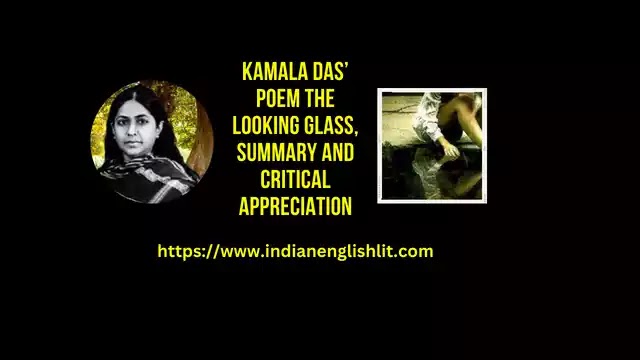 |
| Critical Appreciation of the Poem The Ghaghra in Spate by K.N. Daruwalla |
Introduction:
The poem entitled The Ghaghra in Spate is one of Daruwalla's best poems. This poem deals with a river in flood. It reminds us of Ramanujan's poem A River which depicts a flood in the river Vaikai which passes through the city of Madurai in Tamil Nada in Southern India. The damage and destruction made by the northern river Ghaghra resemble to that of Vaikai, a southern river. So far as the poet's approach to the subject is concerned, there is a big difference between these two poems. This poem is based on the poet's minute observation. It shows how the villagers seem to be helpless before the natural disaster. The poet draws a realistic picture by making a close observation of the flood and destruction made by it.
Thought-Content:
The river Ghaghra is suddenly over-flooded every year and changes its course. Going along the river-bank in the growing darkness of the evening, one can never think that a flood is about to come. The landscape looks perfectly smooth and tranquil. All the activities in the surroundings of the river go on as usual. The sudden approach of water causes panic among the people living close-by. The water of the flooded river rushes into the village nearby, bringing down the mud-and-straw cottages, and forcing the cottagers to take shelter on the rooftops. During these three days the men on the rooftops remain hungry and the cattle are not milked. The children are cheerful enough because they do not comprehend the dangers which they have been facing. The people do not indulge in curses or in any crazy kind of talk because they are familiar with the behaviour of this river. They do not even pray to God for help because they know that the prayers in this situation are futile. The real damage, which the river does, becomes evident only after the flood has subsided.
Realistic and Vivid Imagery:
Stark realism is the chief quality of much of the imagery in Daruwalla's poetry. An outstanding example of this sort of thing is to be found in the poem. In the poem we have the picture of the Ghaghra looking like ‘overstewed coffee', and looking at night like a red weal across the spine of land. And the moon is red because she is having menses! When the flood comes into this river suddenly at night, it is like a nightmare for the people who have to undergo days of hunger and have to find shelter on the rooftops though many of the mud-and-straw houses have already collapsed. When the flood-waters recede, the Ghaghra turns actually "bitchy'. Behind the retreating flood-waters, the land sinks and houses bend down on their knees as if paying their farewell respects to the retreating waters. The paddy fields, which were filled with water and fish, would now begin to dry up, bringing an end to the life of the fish.
Social Concern and Compassion:
There can be no doubt that Daruwalla's interests are varied and that his observation is very keen and minute. But the most pleasing aspect of his treatment of his themes is that his attitude to the various problems and issues of life is always original, and that his poems are therefore by no means state or stereotyped. In the present poem, the havoc worked by the flood in the Ghaghra is the main theme, though not the only one. The poet does not become sentimental here. He shows a remarkable restraint and an attitude of detachment in depicting the horror of the flood as "half a street goes churning in the river-belly", and the thatched cottages just melt away in the flood-waters. A buffalo floats over to the rooftop where men have taken shelter. Much has been left by the poet to our own imagination. He only throws hints to indicate the misery and the suffering, and can even write a word or two to lighten our sense of suffering by saying that children have enough spirit in them to cheer the rescued boats:
"Children have spirit enough in themto cheer the rescue boats;the men are still life-subjectsoozing wet looks. "
Depiction of the Two Catastrophes in the Poem:
The poet depicts two catastrophes in this poem. First is the sudden approach of the flood in the river Ghaghra at night and the second is the damage which the river does after the flood has retreated. There is hardly any sign at that time that a flood is coming. Then landscape is "superbly equipoised", and the kingfishers and the gulls are seen on the river-bank as usual. Then comes the flood, and the mud-and-straw cottages crumble because of the fury of the waters while the men have to take shelter on the roof-tops of those houses which still stand firm. The rescue boats certainly do their job. But the service rendered by them is hardly enough. Then the second catastrophe takes place; the land near the river begins to sink; the houses, which still stood in their places, begin to bend downwards and the fish in the rice-fields begin to die with the water evaporating on account of the heat of the sun.
Style and Language of the Poem:
Daruwalla's poetry abounds in figures of speech and, more particularly in metaphors which are most often strikingly original. In the poem the river is described as being in the afternoon a "grey smudge", and at night as "overstewed coffee". At night under a red moon in menses, the river looks like "a red weal across the spine of the land". The idea of the futility of any prayers in that situation has metaphorically and felicitously been expressed in the following lines:
"No one sends prayers to a wasted skyfor prayers are parabolic."
The manner, in which the fish begin to die as the paddy-fields begin to dry up, has also been described in a most satisfactory, metaphorical manner. Here the poet imagines that the mud has entered into a conspiracy with the sun to strangle the fish in the paddy fields which had been filled with the water from the flooded river. There is a tinge of satire in the following lines which that to the rich the sufferings of the victims of flood are a source of recreation or enjoyment:
"Women in chauffeur-driven carsgo looking for driftwood."






